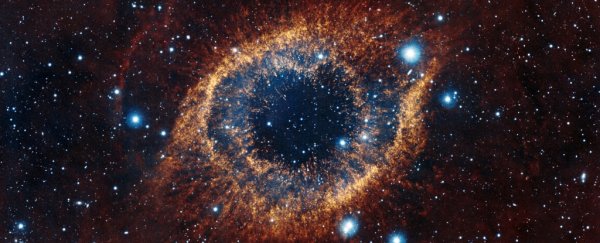The origins of the Solar System's heavy elements such as gold and platinum have been a source of great interest to astronomers. One of the most popular theories is that they were scattered into space by neutron star collisions.
New research, however, has found another origin: an oft-overlooked type of star explosion, or supernova. These, the researchers assert, could be responsible for at least 80 percent of the heavy elements in the Universe.
The particular type in question are collapsar supernovae, produced by rapidly spinning stars more than 30 times the mass of the Sun; they explode in spectacular fashion before collapsing into black holes.
"Our research on neutron star mergers has led us to believe that the birth of black holes in a very different type of stellar explosion might produce even more gold than neutron star mergers," said physicist Daniel Siegel of the University of Guelph.
The neutron star collision detection in 2017 brought the first solid evidence that such collisions produce heavy elements. In the electromagnetic data produced by GW 170817, scientists detected, for the first time, the production of heavy elements including gold, platinum and uranium.
As we previously reported, this happens because a powerful explosion, such as a supernova or stellar merger, can trigger the rapid neutron-capture process, or r-process - a series of nuclear reactions in which atomic nuclei collide with neutrons to synthesise elements heavier than iron.
The reactions need to happen quickly enough that radioactive decay doesn't have a chance to occur before more neutrons are added to the nucleus, which means it needs to happen where there are a lot of free neutrons floating about, such as an exploding star.
In the case of GW 170817, these r-process elements were detected in the disc of material that bloomed out around the neutron stars after they had merged. While working on understanding the physics of this, Siegel and his team realised that the same phenomenon might occur in association with other cosmic explosions.
So, using supercomputers, they simulated the physics of collapsar supernovae. And, boy did they ever strike gold.
"Eighty percent of these heavy elements we see should come from collapsars," Siegel said.
"Collapsars are fairly rare in occurrences of supernovae, even more rare than neutron star mergers - but the amount of material that they eject into space is much higher than that from neutron star mergers."
Moreover, the quantities and distribution of these elements produced in the simulation were "astonishingly similar" to what we have here on Earth, he noted.
So does that mean that 0.3 percent of Earth's r-process elements didn't come from a neutron star collision 4.6 billion years ago, as a different team of astronomers found earlier this year? Well, not necessarily. Under the parameters of Siegel's simulations, up to 20 percent of these elements could still have come from neutron star and black hole smash-ups.
The team hopes the James Webb Space Telescope, currently slated for a 2021 launch, could shed more light on the matter. Its sensitive instruments could detect the radiation pointing to a collapsar supernova in a distant galaxy, as well as elemental abundances across the Milky Way.
"Trying to nail down where heavy elements come from may help us understand how the galaxy was chemically assembled and how the galaxy formed," Siegel said.
"This may actually help solve some big questions in cosmology as heavy elements are a nice tracer."
The research has been published in Nature.
